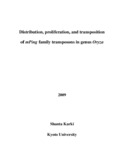Please use this identifier to cite or link to this item:
http://archive.nnl.gov.np:8080/handle/123456789/231| Title: | Distribution, proliferation, and transposition of mPing family transposons in genus Oryza |
| Authors: | Karki, Shanta |
| Keywords: | Transposable elements |
| Issue Date: | 28-Mar-2019 |
| Abstract: | Transposable elements (TEs), commonly referred to as the “jumping genes” are mobile, interspersed repetitive DNA sequences that have no fixed place in the genome. They were discovered and characterized in maize by the novel laureate, Barbara McClintock (1950). TEs constitute significant portions of the eukaryotic genomes; for example, human genome has more than 45% (Biemont and Vieira 2006), Arabidopsis upto 10%, maize more than 60%, and rice has approximately 35% (IRGSP 2005). Initially they were ignored as the selfish, parasitic, or junk genetic elements (Biemont and Vieira 2006). Interest in TEs increased after the draft of the human genome became available. Recently, their importance has greatly increased as a major factor responsible for creating genetic variability due mainly to their ability to cause somatic mutations through excision, insertion, translocation, and irregular recombination. They can create new genes and increase the number of genes by duplication and exon shuffling (Cowan et al. 2005; Morgante et al. 2005; Jiang et al. 2004b). There are several kinds of TEs which vary in structure, mechanisms of transposition, and the choice of target sites. Based on their transposition intermediates, they are broadly classified into two distinct classes (Benjak et al. 2008). They are described in brief as follows: |
| URI: | http://103.69.125.248:8080/xmlui/handle/123456789/231 |
| Appears in Collections: | 300 Social sciences |
Files in This Item:
| File | Description | Size | Format | |
|---|---|---|---|---|
| ShantaKarkiPhDThesis.pdf | 1.83 MB | Adobe PDF |  View/Open |
Items in DSpace are protected by copyright, with all rights reserved, unless otherwise indicated.